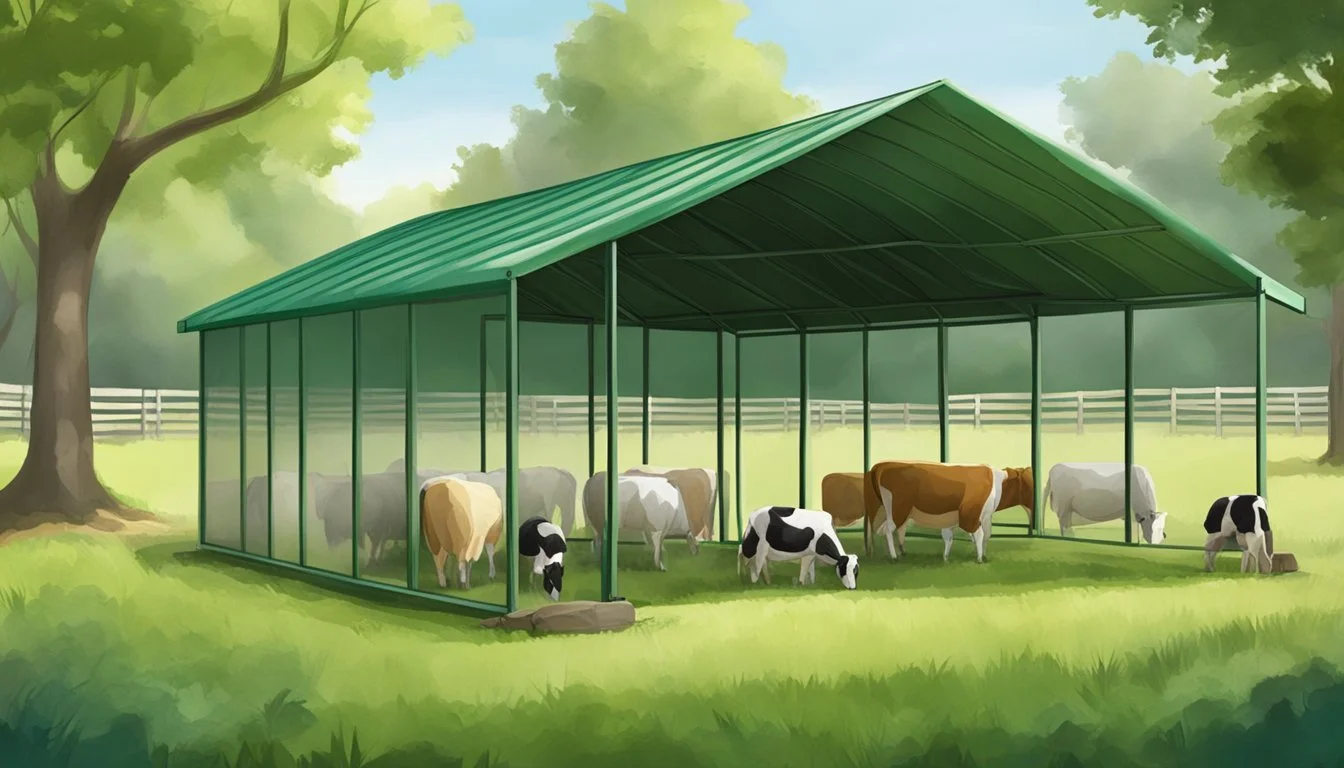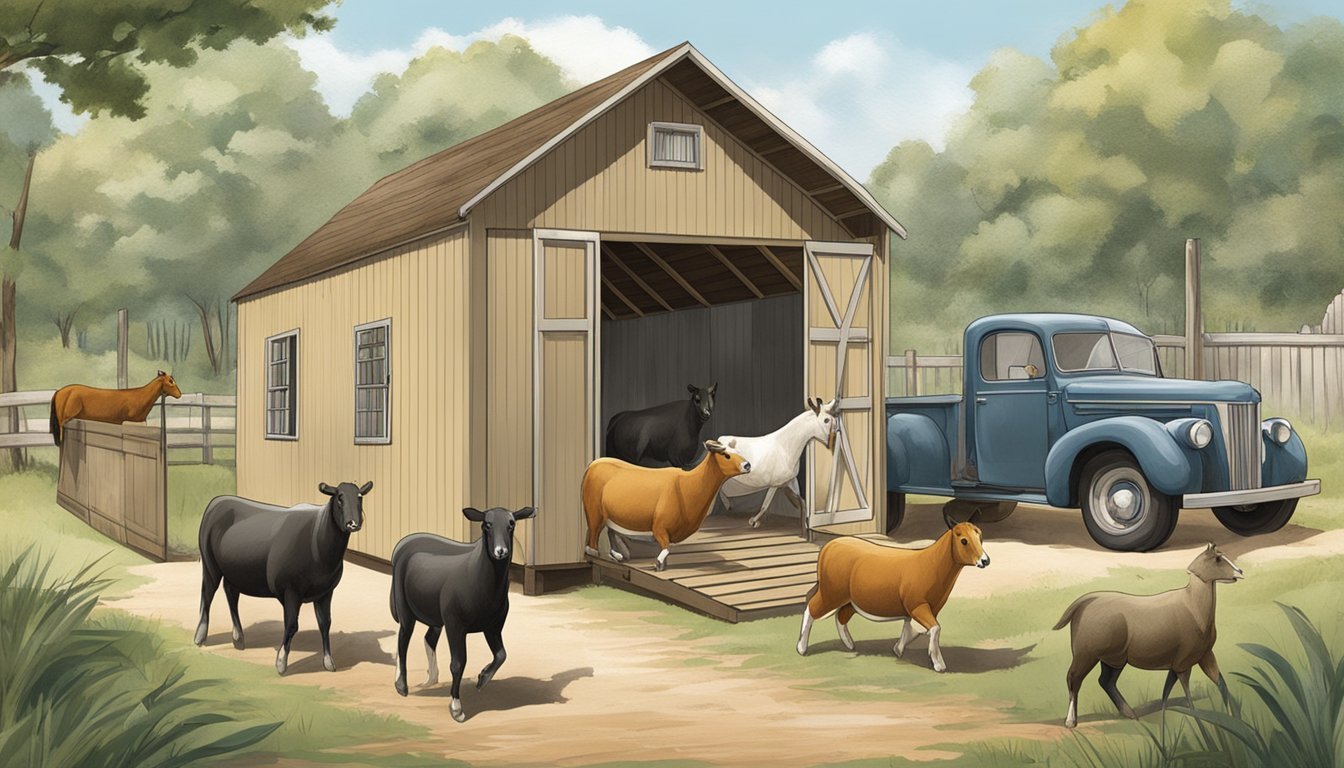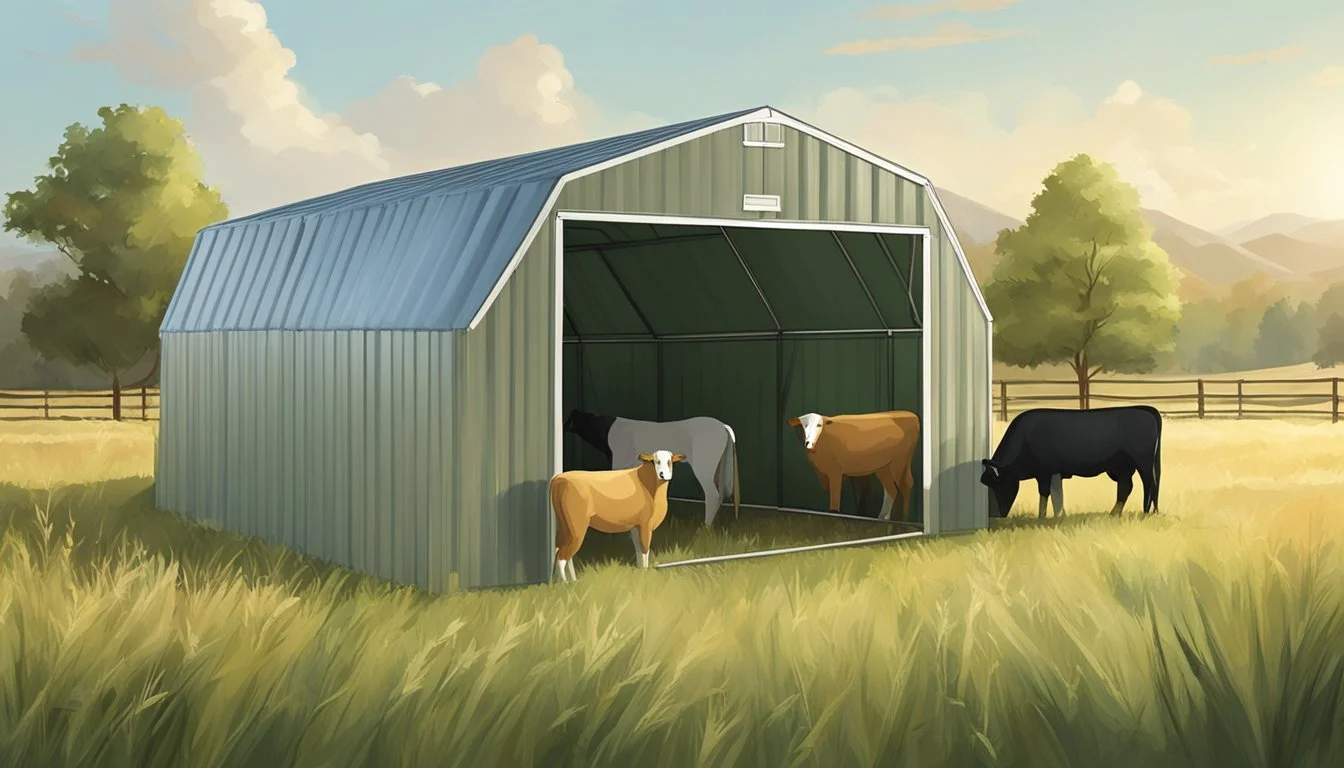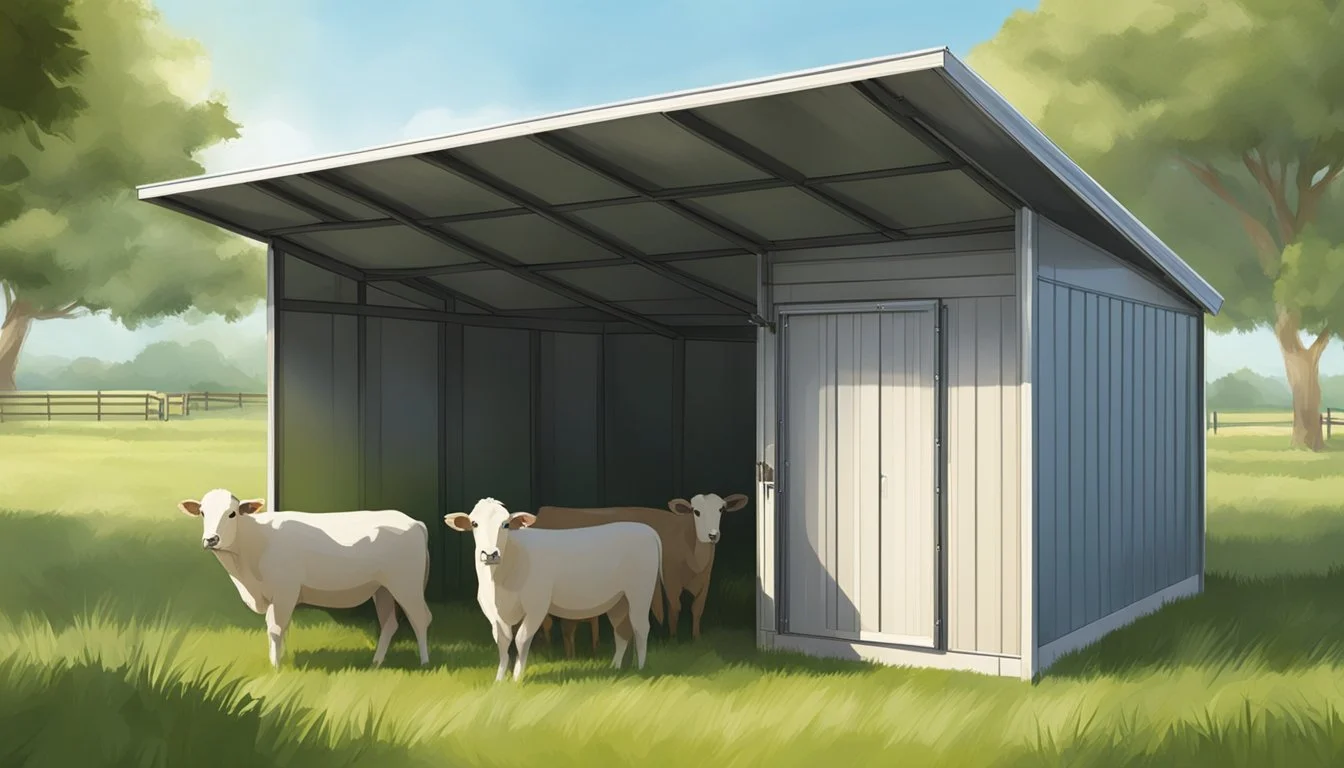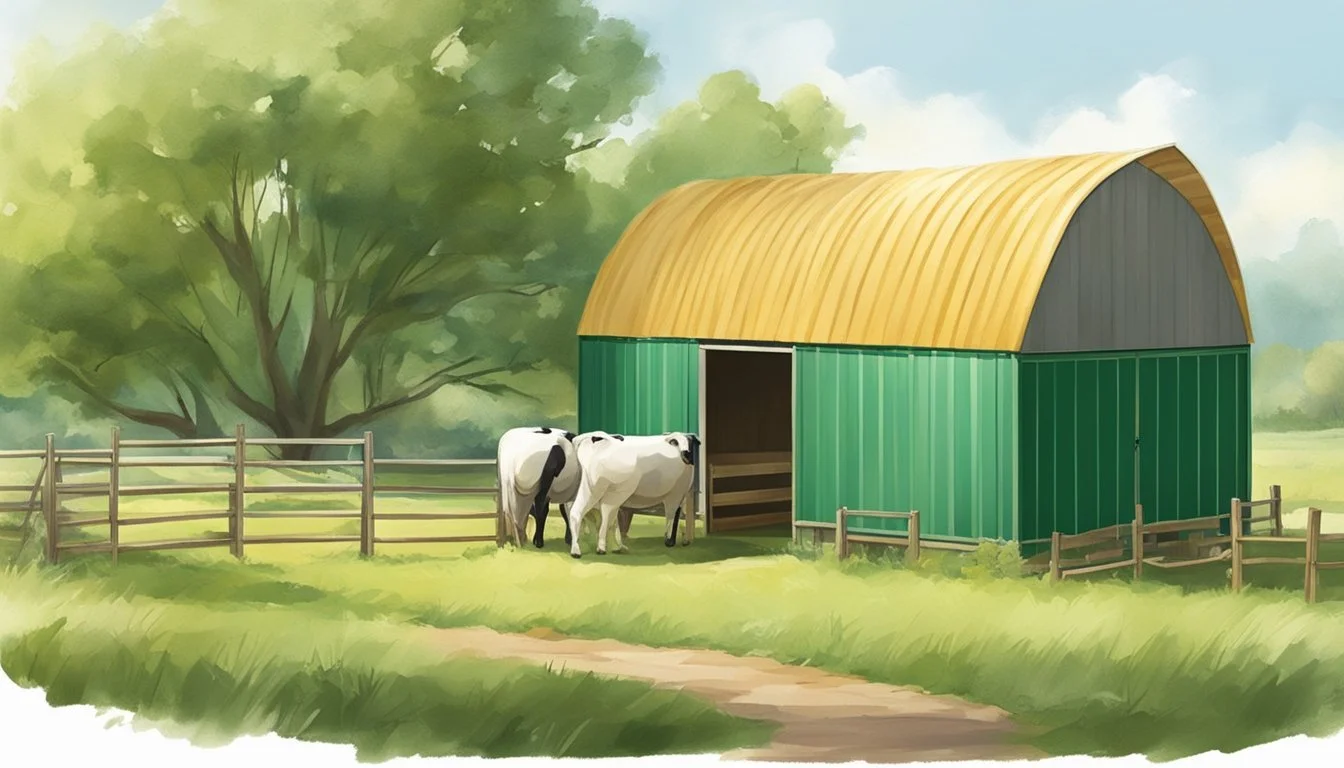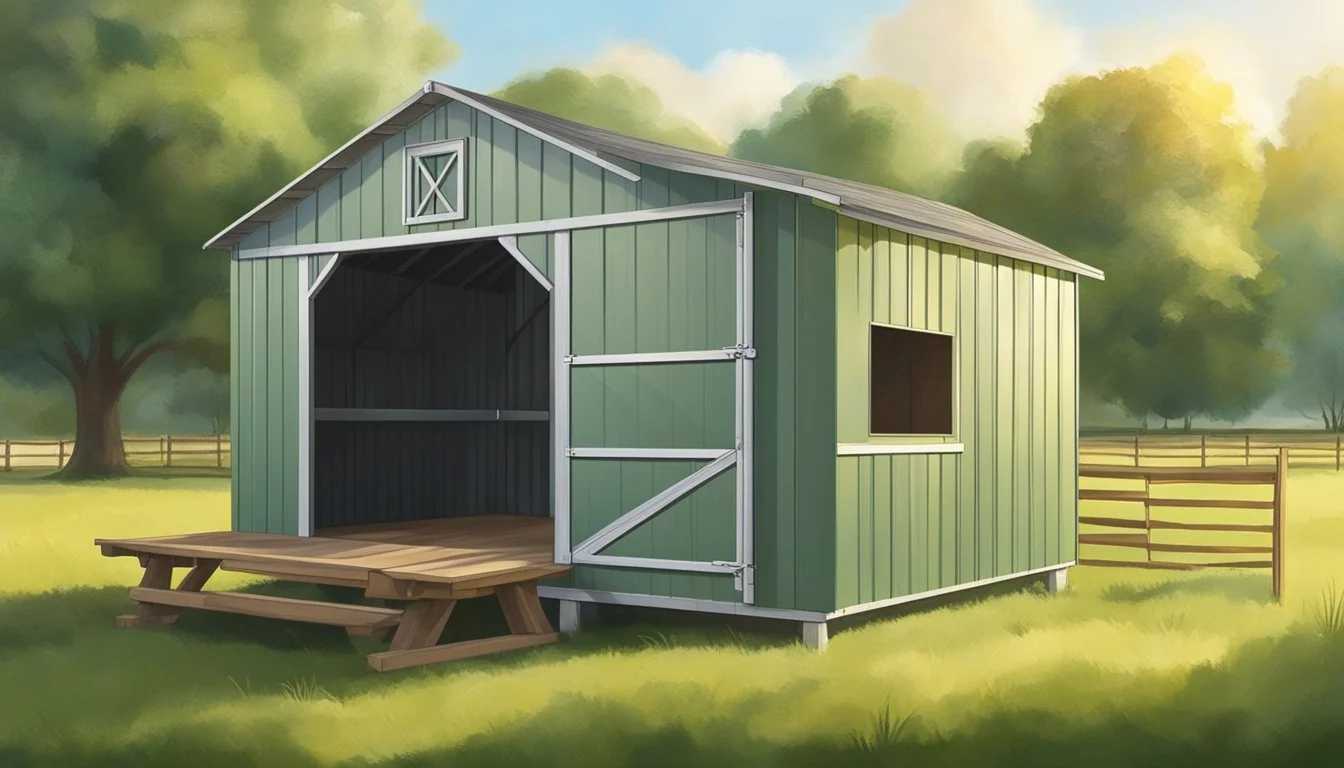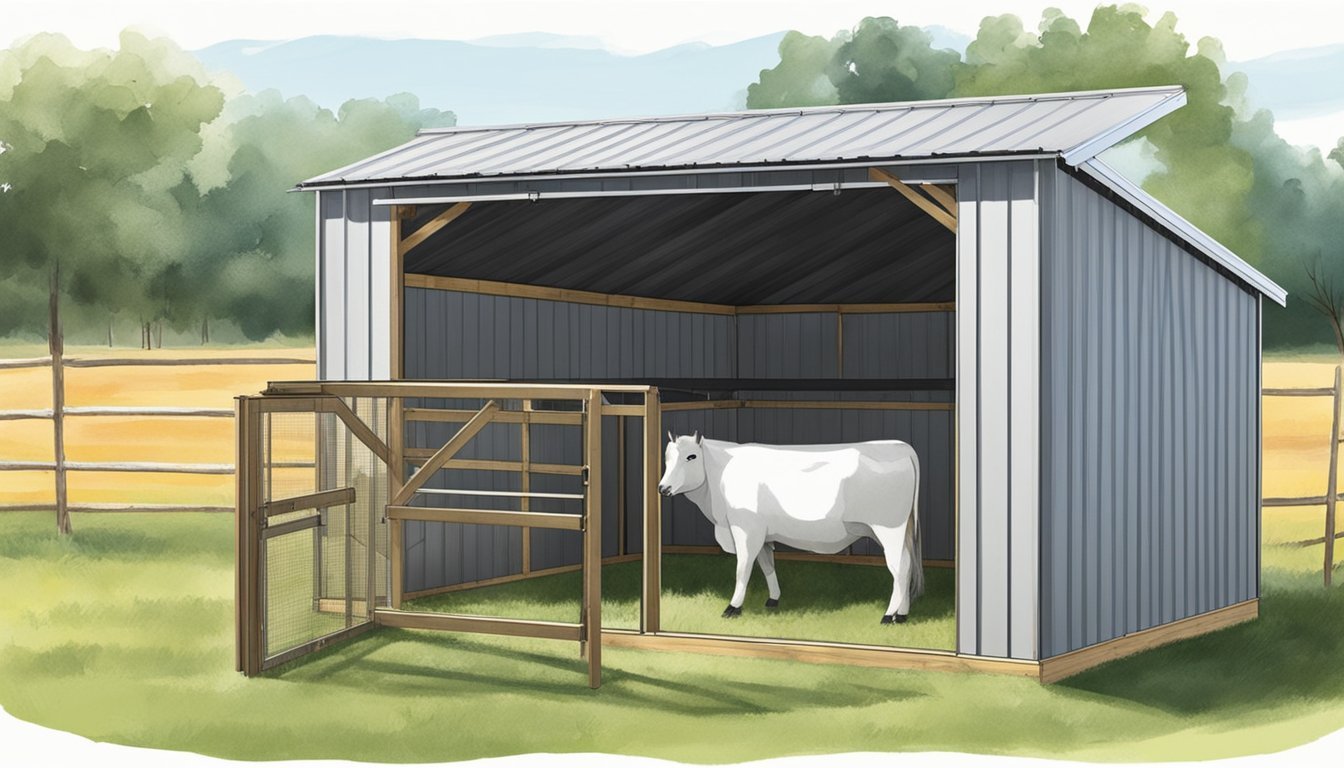The Ultimate Guide to Portable Loafing Sheds for Livestock
Optimal Movable Shelter Solutions
Portable loafing sheds offer an efficient and flexible solution for farmers and homesteaders seeking to provide their livestock with reliable shelter. These structures are designed to cater to the needs of various farm animals, such as horses, cattle, pigs, goats, and sheep. Constructed with mobility in mind, portable livestock shelters can be easily moved to different locations on a farm to accommodate changing grazing patterns and environmental conditions.
The primary function of a loafing shed, also known as a run-in shed, is to protect animals from harsh weather, be it the severe heat of summer or the biting cold of winter. These shelters are typically three-sided, allowing animals the freedom to enter and exit at will, without the constraints of a fully enclosed barn. They are often praised for being sturdier than temporary shelters and not requiring the commitment or expense of a permanent structure.
When choosing a portable loafing shed, several factors come into consideration to suit individual needs, such as ventilation, durability, and size. These factors ensure that the horse or livestock shelter provides a safe and comfortable environment for animals throughout the year. Additionally, some loafing sheds come with the option to add a tack or feed room, providing further convenience for the farmer. The design and materials of these shelters are chosen for their durability and ability to withstand frequent relocations and the wear and tear of farm life.
Why Portable Loafing Sheds?
Portable loafing sheds offer versatility and adaptability for homesteaders who need reliable, movable shelters for their livestock. They blend the necessity of protection with the convenience of mobility.
Benefits of Mobility
Portable livestock shelters provide significant flexibility. They allow farmers to rotate pastures by moving the shelter, which prevents overgrazing and the spread of parasites. Moreover, portable shelters can be strategically relocated to offer animals protection based on seasonal weather conditions. Cost-effective solutions are a priority for any farm, and the portability of these structures can reduce the need for multiple fixed sheds, offering savings in construction and materials.
Ease of Delivery: Many portable loafing sheds come prefabricated, and suppliers often include delivery within certain price ranges.
Adaptability for Family Farms: Sheds can be easily resized or moved to suit the evolving needs of a family farm, from an increase in herd size to diversification of livestock.
Comparing Permanent vs. Portable Structures
When weighing permanent versus portable structures, several considerations come into play, notably around cost and permanence.
Loafing Shed Cost:
Permanent: Higher initial investment due to foundation and construction.
Portable: Generally lower initial cost and the potential for fewer permit requirements.
Shed Size:
Permanent: Tailored to specific dimensions, less adaptable to changing needs.
Portable: Available in various sizes with the added benefit of repositioning as required.
In summary, portable loafing sheds typically require less upfront investment and offer a flexible solution for livestock sheltering needs. Their movability, paired with various size options, makes them a strategic choice for dynamic farming practices.
Selecting the Right Size and Design
When considering a loafing shed for livestock, selecting the right size and design is crucial to meet the needs of the animals and ensure their comfort. Factors such as the type of livestock and the number of animals will greatly influence the structure's dimensions and features.
Understanding Livestock Space Requirements
Space requirements for livestock must be carefully assessed to ascertain that animals have enough room to move, rest, and access feed and water. For example, horses typically need about 100 to 200 square feet per animal in a loafing shed. Cattle, while larger, may require less space per individual, around 40 to 80 square feet, due to their herding behavior. On the other hand, smaller animals like sheep and goats necessitate approximately 15 to 25 square feet per animal.
Customization Options for Various Livestock Types
Loafing sheds must be tailored to the type of livestock they will shelter. For instance, a shed for horses might need higher sidewalls to accommodate their taller stature, while shelters for goats and sheep may incorporate features that prevent drafts at a lower level, suitable for their smaller sizes.
Horses: Higher openings, durable construction to withstand wear.
Cattle: Features to facilitate herding and group movement.
Sheep/Goats: Lower walls, provision for wool and fur protection.
The size and structural design of a loafing shed profoundly impact the health and wellbeing of the livestock, making it a vital aspect to deliberate when planning for movable shelter on a homestead.
Material Considerations for Durability and Protection
When constructing a portable loafing shed, selecting the right materials is crucial for ensuring durability and protection against harsh weather conditions. The choice between wood and metal for construction and the incorporation of weather-resistant features are vital for a structure's longevity and the safety of the livestock it shelters.
Wood vs. Metal Construction
Wood:
Pros: Wood offers a traditional and natural aesthetic. It provides natural insulation, which can be beneficial in both warm and cold climates.
Cons: Requires regular maintenance to protect against decay, pests, and weather-related damage.
Metal:
Pros: Metal, often galvanized steel or aluminum, is known for its strength and ability to resist corrosion. Metal structures typically require less maintenance and can handle significant snow loads.
Cons: Heat conductivity can be a concern; proper insulation and ventilation are necessary to ensure the comfort of the animals.
Weather-Resistant Features
Roof:
A metal roof is often favored for its durability, longevity, and ability to shed precipitation quickly.
Slope design: Critical for directing rain and snow away from the shelter, preventing accumulation that could cause structural damage.
Walls:
Weather-resistant paneling or treated wood can mitigate moisture absorption and decay.
Design should enable adequate airflow to handle varying weather conditions while providing dependable protection.
Each material and design feature should be selected based on the specific needs of the livestock and the environmental challenges of the location to create a safe, enduring shelter.
Key Features of High-Quality Loafing Sheds
High-quality loafing sheds incorporate specific design aspects catering to the well-being and safety of livestock. Durability, sufficient space, and structural soundness form the cornerstone of these shelters. They provide a versatile refuge where animals can comfortably rest and seek protection from the elements.
Importance of Ventilation
Good ventilation in a loafing shed is crucial for maintaining a healthy environment for the livestock. It ensures an ample supply of fresh air which helps in reducing moisture and minimizing the buildup of ammonia gases from animal waste. High-quality loafing sheds typically feature:
Adequate openings: Large enough to facilitate natural airflow yet shielded to prevent the entry of adverse weather elements.
Proper positioning: Sited to take advantage of prevailing winds for optimal cross-ventilation.
Ease of Cleaning and Maintenance
For a loafing shed to provide a safe haven for animals, it must remain clean and well-maintained. Key features that enhance ease of maintenance include:
Accessible design: Wide entrances and open interiors allow for efficient manure removal and cleaning operations.
Durable materials: Use of weather-resistant and corrosion-proof materials ensures longevity and simplifies ongoing upkeep.
Proper Placement and Orientation
When selecting the location for a portable loafing shed, it is crucial to consider environmental influences that could affect the health and comfort of livestock. Careful placement can maximize weather protection and ensure the shed's longevity.
Site Preparation
Before installing a portable loafing shed, one must ensure that the chosen site is level and well-drained. It is advisable to have a gravel or stone base to facilitate proper drainage and to help deter pests. For additional stability, one might consider using anchors, especially in regions prone to high winds or extreme weather.
Leveling the Site: Verify the site is flat to prevent structural stress.
Drainage: Implement a gravel base to promote water runoff and discourage puddling.
Anchoring: Secure the shed against strong winds to protect livestock and the structure itself.
Positioning for Optimal Weather Protection
The shed should be positioned to offer the most effective shelter from weather elements. The orientation of the shed is essential, with the open side typically facing away from the direction of prevailing winds to offer maximum protection from rain, snow, and wind.
Orientation: Place the long side of the shed perpendicular to prevailing wind patterns.
Weather Considerations:
Summer: Ensure proper ventilation and shade to keep animals cool.
Winter: Angle the shed to block cold winds and capitalize on solar warmth.
By following these guidelines, one ensures the portable loafing shed serves its purpose effectively wherever it is placed—be it a farm or a backyard—providing reliable, movable shelter for livestock year-round.
Additional Features and Customizations
When designing a portable loafing shed for livestock, incorporating additional features and customizations can enhance functionality and cater to specific needs. Storage spaces and the right choice of doors and windows can significantly improve the practicality and comfort of these shelters.
Incorporating Storage and Tack Rooms
The inclusion of a tack room within a portable loafing shed provides a secure and convenient space for storing saddles, bridles, and other essential equestrian equipment. Tack rooms should be designed to protect supplies from the elements and should ideally include:
Lockable doors to ensure security
Built-in shelves and hooks for organized storage
These rooms can also serve as additional storage for feed, bedding, and grooming supplies, keeping everything necessary close at hand.
Choosing the Correct Doors and Windows
Selecting the appropriate doors and windows for a portable loafing shed is crucial, both for the accessibility and the wellbeing of the animals. The choices should offer:
Ventilation: Windows should provide adequate airflow, preventing moisture buildup and maintaining a comfortable environment.
Ease of access: Doors must be wide enough to allow easy movement of livestock and equipment in and out of the shed.
Durability: Materials should be robust to withstand daily use and varying weather conditions.
When considering doors and windows, factors like orientation, size, and latching mechanisms are vital to match the specific requirements of the livestock and the climate they inhabit.
Ensuring Safety and Comfort for Your Livestock
When selecting a portable loafing shed, the primary focus should be on providing safety and comfort for livestock. This involves ensuring adequate shelter against varying weather conditions and incorporating secure enclosures and kickboards for animal safety.
Adequate Shelter Against Weather Elements
Loafing sheds must offer robust protection against weather elements. This means the structure should:
Be well-ventilated to handle summer heat.
Provide sufficient insulation for winter conditions.
Include a waterproof and durable roof to keep rain and snow at bay.
Feature orientations and openings that shield animals from severe weather.
Secure Enclosures and Kickboards
For the safety of the occupants, a loafing shed should have:
Sturdy kickboards lining the interior walls to withstand impact from horses or cattle.
Secure latches and enclosure mechanisms to prevent accidental openings.
Enclosures designed to prevent limbs from getting trapped, ensuring the creatures within remain safe and comfortable at all times.
Cost and Value Analysis
When considering a portable loafing shed, purchasers must carefully weigh the initial investment against potential savings and benefits over time.
Balancing Upfront Costs with Long-Term Benefits
Initial Investment: The cost of a portable loafing shed varies depending on size, materials, and features. On average, prices can range between $4,000 and $9,500. For a basic 10x12 shed, buyers might expect to pay approximately $4,115, equating to roughly $27-$37 per square foot. It's important to note that these are structures built to endure, often made of quality materials deserving the upfront cost.
Longevity and Utility: Durable, well-constructed sheds provide shelter for livestock against harsh weather conditions, contributing to their well-being and, as a result, their productivity. Investing in a sturdy shed can prevent costs of property damage and animal health issues, making it a cost-effective choice for the long run.
Exploring Financing and Deals
Financing Options: Buyers should explore financing possibilities that can ease immediate financial burden. Some suppliers may offer payment plans or partner with financing institutions to make the purchase more manageable.
Seeking Deals: Cost-conscious buyers can benefit from deal alerts provided by manufacturers and suppliers, who may offer seasonal discounts or package deals. Affordable and quality sheds are available, but it requires diligence to find the most appropriate deals that align with budget and needs. Staying informed about sales and promotions can lead to significant savings on the purchase of a portable loafing shed.
Installation and Delivery Process
Choosing a portable loafing shed involves not only selecting the right size and materials but also understanding the installation and delivery process. Proper preparation and setup are paramount for ensuring that the shed serves its purpose effectively.
Preparing for Shed Delivery
Before a portable loafing shed arrives, it's essential that the homestead owner prepares the site:
Assess Accessibility: Ensure the delivery path is clear of obstacles and wide enough for the transport vehicle.
Site Selection: Choose a level area for the shed. It should be easily accessible to livestock and free from water loggings, such as standing water or flooding zones.
Table 1: Site Preparation Checklist
Clearing: Remove any debris, branches, or rocks from the delivery area.
Access: Confirm at least a 10-foot-wide clearance for delivery trucks.
Foundation: Opt for a gravel bed or concrete pads for stability.
Permits: Check local building codes to see if any permits are required.
Setting Up Your Portable Loafing Shed
Once the shed is delivered, installation can commence:
Positioning: The shed will be positioned according to the owner’s specific requirements, ensuring the open side faces away from prevailing winds.
Anchoring: To prevent shifting, the shed must be anchored securely to the chosen foundation.
Table 2: Installation Steps
Step 1: Lay down the base material (gravel or concrete blocks).
Step 2: Align the shed to its final position.
Step 3: Secure the shed to the foundation using appropriate fastening methods, such as ground anchors or anchors suitable for concrete.
Following these guidelines will result in a stable and secure environment for the livestock that relies on the protection provided by the portable loafing shed.
Maintenance and Care Tips
Proper maintenance and care are critical for ensuring the longevity and durability of portable loafing sheds. By implementing routine upkeep and paying careful attention to the materials' integrity, one can preserve the functionality and appearance of these movable shelters.
Routine Upkeep
Cleaning: Regularly removing dirt, manure, and debris from the interior of the shed prevents the accumulation of moisture and corrosives that could damage the structure.
Inspection: They should inspect the shed's exterior periodically for signs of wear and tear, paying close attention to areas that might need repair or reinforcement.
Pest Control: Implement pest control measures to prevent damage from insects or rodents, such as sealing gaps and using appropriate repellents.
Ventilation: Ensure that the shed is well-ventilated to prevent the buildup of condensation, which can lead to mold or mildew, jeopardizing the health of the livestock.
Relocation: When sheds are relocated, examine the new site for level ground to prevent structural stress and ensure adequate drainage.
Longevity of Materials
Protective Coatings: Apply protective coatings to wooden components to guard against rot and weather elements. For metal parts, they may use rust-resistant paint to impede corrosion.
Replacement Parts: They promptly replace components showing significant wear or damage, such as roof panels, anchors, or fasteners, to maintain the shed's structural integrity.
Weatherproofing: Regularly check and maintain seals around doors and windows to keep the elements out. Reapply caulking or weather-stripping as necessary.
Foundation Care: If the shed rests on a wooden or concrete foundation, they should inspect and maintain these to prevent shifting or degradation due to weather or load.
Legal and Zoning Considerations
Before erecting a portable loafing shed, it's crucial to navigate the maze of local zoning laws and secure the necessary permits, ensuring compliance and avoiding legal pitfalls.
Understanding Local Regulations
Local zoning regulations govern the placement, size, and usage of structures on a property. It's imperative to check with local building authorities or the municipal planning department to understand specific requirements. These regulations can include setbacks from property lines, maximum allowable structure sizes, and height limitations. Local conservation laws may also be relevant if the structure will be near wetlands or protected habitats.
Permits and Restrictions
The requirement for permits varies by location, but in many cases a permit may be required for a loafing shed, even if it's portable. Typical restrictions to consider include:
Purpose of the structure: Some zones may restrict the use to agriculture-related activities.
Mobility: Whether or not the structure is on a permanent foundation can affect permit requirements.
Utilities: If the shed requires water or electricity, additional permits and inspections might be necessary.
Neighborhood associations: Additional covenants or bylaws may apply in certain communities.
To ensure legality, property owners should research thoroughly and maintain open communication with local authorities throughout the process to keep their portable loafing sheds within legal parameters.
Additional Resources and Support
In the search for the ideal portable loafing shed for livestock, customers often require additional support and resources. Manufacturers and retailers offer a wealth of information and assistance to aid in the selection and maintenance of movable shelters.
Manufacturer and Retailer Information
Customers seeking out portable loafing sheds will find Kauffman Structures as a notable provider. They offer a range of sizes, from 10'x18' to 12'x24', catering to various livestock needs. For those who wish to delve deeper into product offerings or have specific questions about the sheds, contacting the manufacturer directly is advisable. Kauffman Structures and other reputable retailers often have comprehensive websites, complete with detailed product information, FAQs, and shed inquiry forms.
Contact Information:
Phone: Available on the manufacturer's website
Email: Typically provided for customer service or via a shed inquiry form
Physical Address: For local dealers, addresses can be found online
Expert Advice and Customer Service
Knowledgeable expertise is a keystroke away, with many manufacturers offering tailored advice via customer service platforms. Apart from providing guidance on choosing the correct shed size and materials for specific livestock, experts can also assist with site preparation and shed installation tips. E-Impact Marketing, specialists in website design and SEO, ensure that websites such as Kauffman Structures' are easy to navigate and provide in-depth information.
Customer Service Resources:
Live Chat: Real-time assistance on the company's website
Phone Consultation: For a more personal touch in addressing customer concerns
Help Guides and Articles: Found online to offer additional insight into maintenance and shed optimization
Manufacturers value the importance of customer satisfaction and aim to streamline the decision-making process by combining quality online resources with responsive customer support.
Conclusion
When considering a portable loafing shed for livestock, it is evident that the benefits are substantial for both animals and owners. These structures offer reliable shelter from the elements, contributing to the well-being of horses, cattle, pigs, goats, and sheep. The variety in sizes, typically ranging from 10'x18' to 12'x24', means there is a fit for almost any scale of farming operation.
Customization options in portable loafing sheds cater to specific needs—whether that’s a certain size or additional features like ventilation or weather protection. Beyond that, the use of durable materials, such as solid wood or metal, affords longevity and dependability. Farmers find peace of mind knowing their livestock is protected.
From a financial standpoint, these sheds represent a cost-effective solution, with prices varying widely to accommodate different budgets. Fabric sheds offer a more temporary and affordable option, while higher-end, prefabricated models are available for those requiring more permanent solutions.
In summary, a portable loafing shed is an investment in farm efficiency and animal comfort. By ensuring that livestock has access to safe and sturdy shelters, farmers enhance the overall health and productivity of their herds, driving their agricultural success forward.
Appendix
This appendix section serves to clarify terminology and address common inquiries related to portable loafing sheds for livestock. Its aim is to support readers in comprehending the finer details that contribute to making informed decisions regarding movable shelter on their homestead.
Glossary
Loafing Shed: A three-sided structure designed to provide shelter for livestock, typically horses, cattle, goats, and sheep, which can be relocated as needed.
Pressure Treated Runners: Wooden beams treated with preservatives to resist decay, insects, and weather damage, often used as the base of loafing sheds.
Gable Roof: A roof with two sloping sides that come together at a ridge, commonly used in loafing shed designs for effective rain runoff.
FAQs
What is a loafing shed? A loafing shed is a movable structure that offers outdoor shelter for livestock, allowing them to rest and stay protected from the elements.
How much does a loafing shed typically cost? Prices can vary widely, but they generally start at around $3,500 and can go up to $9,000 or more, depending on size, materials, and additional features.
Are loafing sheds considered permanent structures? No, they are designed to be portable, allowing for relocation according to the needs of the farm or homestead.
Can loafing sheds be customized? Yes, they can be customized with various options such as tack or feed rooms, different sizes, and materials to suit specific needs.
Readers should consult the privacy policy of manufacturers or retailers to understand how their personal information is handled when inquiring or purchasing loafing sheds.
About the Author
The author of "The Ultimate Guide to Portable Loafing Sheds for Livestock: Ensuring Movable Shelter on Your Homestead," brings a wealth of experience and expertise to the topic.
Background: With a degree in Agricultural Science and over a decade of hands-on experience in farm management, the author is well-versed in the needs and challenges of livestock care.
Expertise: Specializing in animal husbandry, the author has collaborated with professionals in the design and construction of livestock shelters. Their knowledge extends to both traditional and innovative materials and methods.
Recognition: Acknowledged by peers for their contribution to sustainable farming practices, especially in developing cost-effective shelter solutions.
Publications: The author has previously written articles for farming magazines and trade journals, providing insights into effective farm infrastructure.
Industry Involvement: They are an active member of various agricultural committees, working towards the improvement of livestock welfare standards.
The guide is an amalgamation of their practical knowledge with the latest industry trends to provide readers with accurate, actionable information.

